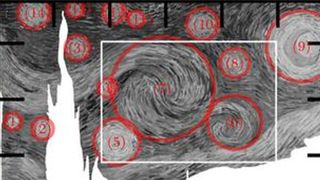New analysis suggests there’s moreover further to Vincent van Gogh’s well-known portray Starry Evening time time than meets the attention. Its turbulent, swirling sky shares many traits with invisible fluid dynamics processes that happen in our real-world setting, an evaluation of the brushstrokes and colours all by the use of the portray reveals.
Van Gogh painted Starry Evening time time in June 1889, whereas he was dwelling in an asylum in southern France as he recovered from a psychological breakdown that resulted all by the use of the self-mutilation of his left ear spherical six months earlier. The oil-on-canvas masterpiece reveals the view of a swirling sky from the window of the painter’s room with an imaginary village added all by the use of the foreground, and is thought for its detailed brushstrokes and use of vivid hues.
The portray at present caught the attention of researchers in China who acknowledged some similarities between its spiraling shapes and the patterns seen in fluid dynamics — the evaluation of the actions of fluids and gases. This impressed them to overview the portray in larger ingredient.
Contained within the mannequin new evaluation, revealed Tuesday (Sept. 17) all by the use of the journal Physics of Fluidsthe researchers analyzed the minute particulars of the brushstrokes and colours used all by the use of the work and located that these parts each shared sturdy similarities with the “hidden turbulence” of gases all by the use of the setting.
“It reveals a deep and intuitive understanding of pure phenomena,” evaluation co-author Yongxiang Huanga fluid dynamics educated and oceanographer at Xiamen School in China, talked about in a assertion. “Van Gogh’s precise illustration of turbulence could very nicely be from discovering out the motion of clouds and the setting or an innate sense of analysis one of many easiest methods to seize the dynamism of the sky.”
Associated: Hidden Van Gogh self-portrait found beneath ‘peasant woman’ portray

The researchers rigorously analyzed the 14 “whirls” all by the use of the portray’s sky. Full, these shapes usually adopted patterns predicted by Kolmogorov’s regulation — a bodily rule that describes how atmospheric gasoline strikes at completely completely fully completely totally different scales relying on inertial vitality. Contained throughout the portray, that inertial vitality is represented by the depth of the yellows all by the use of the portray, the researchers wrote.
When the researchers appeared further rigorously on the whirls, together with they discovered the spacing and weight of particular specific particular particular person brushstrokes revealed an alignment with Batchelor’s scaling, which describes how small eddies and droplets could also be prior to they dissipate in a turbulent fluid.
Nonetheless, Kolmogorov and Batchelor developed their licensed pointers loads of years after the artist died. So, the authors wrote, Van Gogh was positively not utilizing fluid dynamics data, nonetheless perhaps drawing on widespread observations of the sky or completely fully completely totally different naturally occurring spirals as inspiration. Equally, the connection between vitality and the colour yellow is sort of positively a coincidence, the authors well-known.

Nonetheless it completely’s clear that Starry Evening time time evokes processes that crop up all by the use of the pure world.
In 2020, researchers named a mannequin new species of peacock spider after the portray due to a similarity between van Gogh’s vibrant swirls and luminous dots on the arachnid’s rear finish. And in 2021, microbiologists furthermore seen a dangling similarity between the portray’s iconic swirls and swarming colonies of mutated micro organism.
In Could this yr, new photos of Jupiter from NASA’s Juno probe furthermore confirmed intense storm swirls all by the use of the planet’s northern hemisphere which appeared just like van Gogh’s newly analyzed brushstrokes. These swirling clouds have been furthermore linked to “turbulent patterns” in Jupiter’s setting, an equal to those on Earth.
